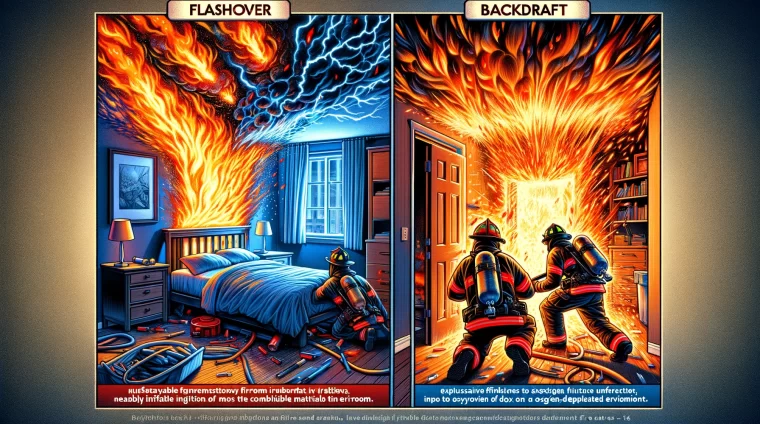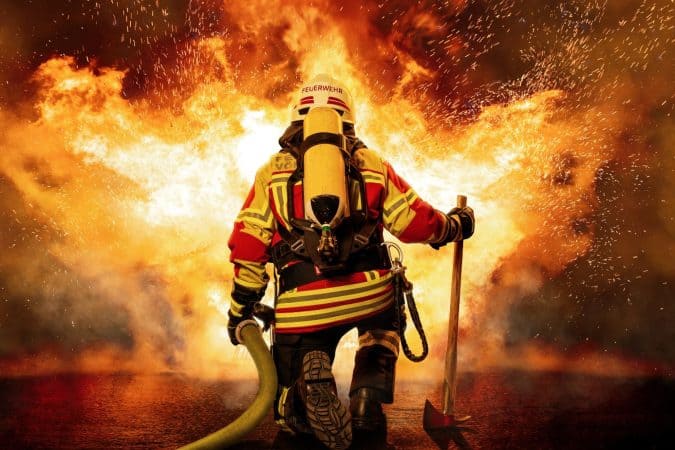No products in the cart.
Backdraft And Flashover: Understanding Essential Dynamics
A course by
-
- March 10, 2024
English
Lifetime access
3 quizzes
Description
Curriculum
Instructor
What you'll learn
1.1 What Are Backdrafts and Flashovers?
In the realm of firefighting, understanding the nuances between backdrafts and flashovers is paramount. Backdrafts and flashovers represent two distinct yet potentially deadly fire phenomena, each posing unique challenges to firefighter safety and structural integrity.
Backdrafts: A Sneaky Threat
Backdrafts occur when a fire-starved environment suddenly receives a rush of oxygen, resulting in a rapid, explosive reignition. Imagine a room filled with smoldering embers, awaiting the perfect moment to erupt into a fiery explosion. This is the essence of a backdraft—a silent, stealthy threat lurking within the shadows of smoke-filled spaces.

Flashovers: The Inferno Unleashed
In contrast, flashovers embody the ferocity of a fire unleashed. Unlike backdrafts, which are characterized by sudden reignitions, flashovers represent a near-simultaneous ignition of all combustible materials within an enclosed space. Picture a room engulfed in flames from floor to ceiling within seconds—that’s the devastating power of a flashover.
1.2 Importance of Understanding Fire Dynamics
The importance of comprehending fire dynamics cannot be overstated in the firefighting profession. Backdrafts and flashovers present unique challenges, requiring not only tactical prowess but also a deep understanding of the underlying physics and chemistry at play.
Protecting Lives, Preserving Property
At its core, firefighting is a mission of preservation—preserving lives, property, and communities. Understanding the critical differences between backdrafts and flashovers empowers firefighters to make informed decisions in the heat of the moment, safeguarding both themselves and those they serve.
Enhancing Operational Effectiveness
Moreover, a nuanced understanding of fire dynamics enhances operational effectiveness on the frontlines. By recognizing the warning signs of impending backdrafts and flashovers, firefighters can proactively mitigate risks, execute strategic interventions, and ultimately achieve better outcomes in high-stakes firefighting scenarios.
Advancing Firefighter Safety
Ultimately, the pursuit of knowledge surrounding backdrafts and flashovers is a pursuit of firefighter safety. By delving into the intricacies of these phenomena, firefighters equip themselves with the tools, techniques, and insights necessary to navigate the complexities of modern fire suppression effectively.
In the subsequent chapters, we delve deeper into the world of backdrafts and flashovers, exploring their definitions, dangers, scientific underpinnings, and firefighting strategies. Stay tuned as we unravel the mysteries of fire dynamics and arm firefighters with the knowledge they need to conquer the flames.
Curriculum
- 1 Section
- 9 Lessons
- Lifetime
Expand all sectionsCollapse all sections
- Flashover and Backdraft12
- 0.0Introduction to Backdrafts and Flashovers
- 0.1Effective Online Study
- 0.2Backdrafts: Understanding the Phenomenon
- 0.3The Science Behind Backdrafts
- 0.4Quiz 116 Questions
- 0.5Flashover: The Swift and Deadly Fire Event
- 0.6The Science of Flashovers
- 0.7Identifying Early Warning Signs of Backdraft and Flashover
- 0.8Quiz 217 Questions
- 0.9Training and Technology: Tools of the Trade
- 0.10Conclusion Recap of Key Points
- 0.11Quiz 38 Questions
Ken Ashford 
16 Students12 Courses
Ken Ashford is a seasoned Australian bushfire expert, bringing over 39 years of hands-on experience to the field. His journey began with 15 years as a dedicated volunteer firefighter, committed to protecting communities. He later spent 24 years as a career firefighter, where he gained deep insights into fire behavior and its unique relationship with Australia’s environment.
Ken's expertise is backed by solid academic credentials, including a Graduate Certificate in Fire Engineering and an Associate Diploma in Fire Technology. His knowledge and advice remain highly sought after by those eager to learn more about bushfire management and firefighting techniques.
Review

$49.95 $29.95
100% positive reviews
6 students
9 lessons
Language: English
3 quizzes
Assessments: Yes
Available on the app
Unlimited access forever
Skill level Beginner
Courses you might be interested in
Coming Soon! Expection publication on the 4th of October. This part 1 of the Climate Change Series. Discover Essential Knowledge on Bushfires and Wildfires Welcome to our comprehensive “Introduction to Bushfires...
- 5 Lessons
$49.95$29.95
Unlock the full potential of the JET-USA TX870 Commercial Pressure Washer with our in-depth operation and safety course, designed for both beginners and seasoned users. This course will guide you...
- 3 Lessons
Free
Lesson Summary: 18HP Petrol Wood Chipper and Mulcher – Powerful Yard Equipment This lesson provides a comprehensive overview of the 18HP Petrol Wood Chipper and Mulcher, covering essential information about...
- 2 Lessons
Free
Introduction to Fire Investigation Understanding Fire Science The Scene of the Fire Evidence Identification /Preservation Documentation and Recording Cause and Origin Determination Working with Investigation Teams Case Studies and Practical...
- 12 Lessons
$175.00$98.95



